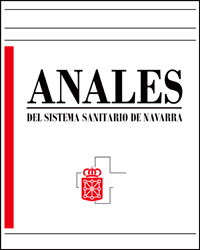Cranio-facial-cervical and subglottic hemangioma with respiratory symptoms. A therapeutic emergency
DOI:
https://doi.org/10.23938/ASSN.0929Keywords:
Subglottic hemangioma, Propranolol, StridorAbstract
We describe the case of a 41-day-old infant with a left craniofacial cervical and subglottic hemangioma with respiratory symptoms. Although infantile hemangiomas are occasional benign vascular tumors that appear predominantly on the skin, 1-2% of patients may have airway lesions that can sometimes cause potentially life-threatening respiratory conditions.
The decision was made to immediately commence treatment with propranolol, without waiting to complete the extension and syndromic diagnoses. There was a positive clinical response and respiratory symptoms dissipated in twelve hours. Early treatment with beta-blockers is essential for children with hemangiomas whose location causes symptoms or significant functional changes: in some cases it may be a matter of urgency.
Downloads
References
BASELGA E, DEMBOWSKA B, PRZEWRATIL P, GONZALEZ MA, WYRZYKOWSKI D, TORRELO A et al. Efficacy of propranolol between 6 and 12 months of age in high risk infantile hemangioma. Pediatrics 2018; 142: e20173866. https://doi.org/10.1542/peds.2017-3866
SOLMAN L, GLOVER M, BEATTLE PE, BUCKLEY H, GACH JE, GIARDINI A et al. Oral propranolol in the treatment of proliferating infantile haemangiomas: The British Society for Paediatric Dermatology consensus guidelines. Br J Dermatol 2018; 179: 582-589. https://doi.org/10.1111/bjd.16779
METRY DW. Infantile hemangiomas: Epidemiology, pathogenesis, clinical features, and complications. En: Levy ML, Corona R, editores. Waltham: UpToDate 2019. https://www.uptodate.com/contents/infantile-hemangiomas-epidemiology-pathogenesis-clinical-features-and-complications/print
MENDIRATTA V, VARGHESE B, CHANDER R, PARAKH A, SOLANKI R. Successful management of airway hemangioma with propranolol. Int J Dermatol 2013; 52: 750-752. https://doi.org/10.1111/j.1365-4632.2012.05752.x
LARANJO S, COSTA G, PARAMES F, FREITAS I, DIOGO J, TRIGO C et al. The role of propranolol in the treatment of infantile hemangioma. Rev Port Cardiol 2014; 33: 289-295. https://doi.org/10.1016/j.repc.2013.10.018
CHEIRIF O, NOVELO AD, OROZCO L, SAEZ M. Hemangioma infantil: actualización del tratamiento tópico y sistémico. Bol Med Hosp Infant Mex 2019; 76: 167-175. https://doi.org/10.24875/bmhim.19000002
VIVAS GV, FERNANDEZ I, LOPEZ JC, FERNANDEZ MA, GARCIA MA, MATUTE DE CARDENAS JA. Analysis of the therapeutic evolution in the management of airway infantile hemangioma. World J Clin Pediatr 2016; 5: 95-101. https://doi.org/10.5409/wjcp.v5.i1.95
IGARI Y, TAKAHASHI S, USUI A, KAWASUMI E, FUNAYAMA M. Sudden death in a child caused by a giant cavernous hemangioma of the anterior mediastinum. J Forensic Leg Med 2017; 52: 93-97. https://doi.org/10.1016/j.jflm.2017.08.008
LITTLER ER, ARBOR A. Asphyxia due to hemangioma in trachea. J Thorac Cardiovasc Surg 1963; 45: 552-558.
HOEGER PH, HARPER JI, BASELGA E, BONNET D, BOON LM, DEGLI MC et al. Treatment of infantile haemangiomas: Recommendations of a European expert group. Eur J Pediatr 2015; 174: 855-865. https://doi.org/10.1007/s00431-015-2570-0
DENOYELLE F, LEBOULANGER N, ENJOLRAS O, HARRIS R, ROGER G, GARABEDIAN EN. Role of propranolol in the therapeutic strategy of infantile laryn-gotracheal hemangioma. Int J Pediatr Otorhinolaryngol 2009; 73: 1168-1172. https://doi.org/10.1016/j.ijporl.2009.04.025
ONDER S, GERGIN O, KARABULUT B. A life threatening subglottic and mediastinal hemangioma in an infant. J Craniofac Surg 2019; 30: e402-e404. https://doi.org/10.1097/scs.0000000000005340
ÁLVAREZ H, PENCHYNA J, TEYSSIER G, MORERA E, DE LA TORRE C, VILLAMOR P. Tiempo de respuesta terapéutica al propranolol sistémico en el manejo de hemangiomas subglóticos pediátricos: serie de casos y revisión de la literatura. Bol Med Hosp Infant Mex 2018; 75: 377-382. https://doi.org/10.24875/bmhim.18000043
TORRELO A, TAMARIZ A, DOMÍNGUEZ MJ. Observaciones clínicas sobre el uso de propranolol en hemangiomas de vía aérea infantil. Acta Otorrinolaringol Esp 2010; 61: 365-370. https://doi.org/10.1016/j.otorri.2010.01.014
ELLURU RG, FRIESS MR, RICHTER GT, GRIMMER JF, DARROW DH, SHIN JJ et al. Multicenter evaluation of the effectiveness of systemic propranolol in the treatment of airway hemangiomas. Otolaryngol Head Neck Surg 2015; 153: 452-460. https://doi.org/10.1177/0194599815591809
OLSEN GM, HANSEN LM, STEFANKO NS, MATHES E, PUTTGEN KB, TOLLEFSON MM et al. Evaluating the safety of oral propranolol therapy in patients with PHACE Syndrome. JAMA Dermatol 2020; 156: 186-190. https://doi.org/10.1001/jamadermatol.2019.3839
Downloads
Published
How to Cite
Issue
Section
License
Copyright (c) 2021 Anales del Sistema Sanitario de Navarra

This work is licensed under a Creative Commons Attribution-ShareAlike 4.0 International License.
La revista Anales del Sistema Sanitario de Navarra es publicada por el Departamento de Salud del Gobierno de Navarra (España), quien conserva los derechos patrimoniales (copyright ) sobre el artículo publicado y favorece y permite la difusión del mismo bajo licencia Creative Commons Reconocimiento-CompartirIgual 4.0 Internacional (CC BY-SA 4.0). Esta licencia permite copiar, usar, difundir, transmitir y exponer públicamente el artículo, siempre que siempre que se cite la autoría y la publicación inicial en Anales del Sistema Sanitario de Navarra, y se distinga la existencia de esta licencia de uso.








